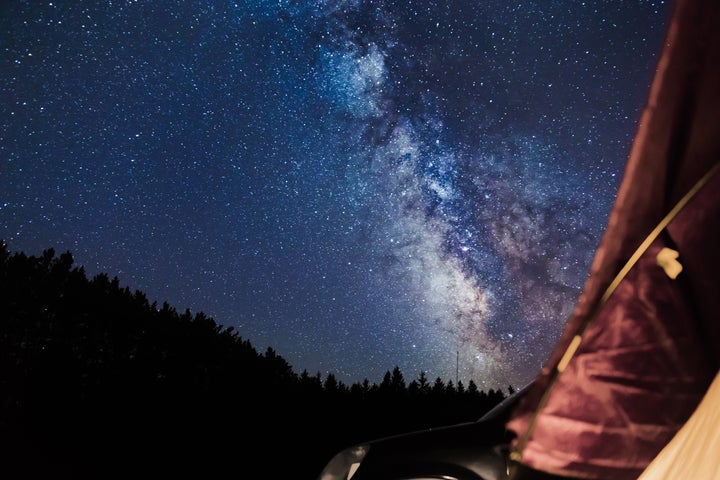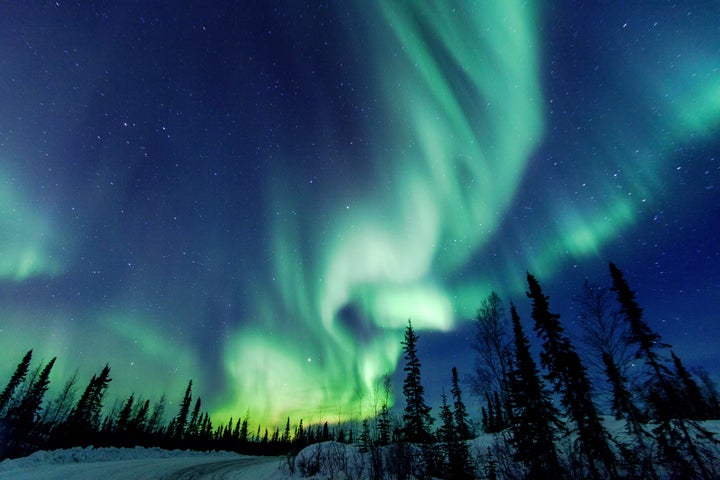Your own backyard is probably even on the list. Here’s where to go and how to properly soak in the night sky.
Stars, moons, planets and galaxies were the hot topics of conversation after NASA released jaw-dropping new photos from the James Webb Space Telescope earlier this summer.
But, outside of the occasional release of new space photos, it can be hard to truly appreciate the night sky.
“There’s a reason why everybody’s not a stargazer,” said Ken Walczak, senior manager for Far Horizons at Adler Planetarium in Chicago. “One hundred years ago, everybody was a stargazer, because 100 years ago [was] before the rampant advent of outdoor electric lighting.”
Walczak added that, at one time, everyone could see the Milky Way from their yard ― now, it’s more of a challenge. For those who do want to see the Milky Way, or other items in the night sky, there are ways to do so. Here are some great travel destinations for seeing stars, planets and nebulae, along with stargazing tips from experts.

Cherry Springs State Park in Coudersport, Pennsylvania
“In Pennsylvania, there’s a really well-known location here called Cherry Springs State Park,” said Derrick Pitts, chief astronomer at the Franklin Institute in Philadelphia. “They are set up specifically for telescopic observers.”
He added that the park is so outfitted for stargazers that if you get there after dark, you’ll see what looks like a drive-in movie parking lot. You’ll find rows separated by posts that are power stations for telescopes.
Maunakea Visitor Information Station in Hilo, Hawaii
According to Pitts, Maunakea is a major astrological location on the Big Island that is home to an astrologer-only summit. The destination also features a visitor’s station where you can get a prime view for stargazing.
The station is roughly 9,000 feet up in the air and is really dark. “They don’t allow any light up there, and all of the rest of the light is on the coast and thousands of feet below you,” Pitts said.
Beyond stargazing, the area is also a popular place for hiking.
Mark Twain National Forest in Rolla, Missouri
“Generally, that whole area in Southeastern Missouri is really remote and nice,” Walczak said.
Specifically, Mark Twain National Forest is a great place to visit for stargazing in the state. You can also hike, camp, or go boating while visiting the area.
Gila National Forest in Silver City, New Mexico
One of Walczak’s favorite places for stargazing is Gila National Forest in New Mexico. Particularly, he recommended visiting Quemado Lake within the National Forest. There, you’ll find a campground at an elevation of nearly 7,000 feet, putting you up high enough in the dark to get a really good glimpse of the stars.
Great Basin National Park in Baker, Nevada
“Great Basin National Park in Nevada is also an amazing observing site,” Walczak said.
He added that the park is also very supportive of astrotourism and has a range of special events and offerings throughout the year. You can visit for its annual Astronomy Festival in the fall, attend a tour on Nevada Northern Railway’s star train or view the sky from the park’s on-site solar telescopes.
University of Texas’ McDonald Observatory in Fort Davis, Texas
“High up in the Guadalupe Mountains is where McDonald Observatory is located,” said Tracy Knauss, director of astronomy at the Houston Museum of Natural Science’s George Observatory.
The observatory stands at about 5,600 feet above sea level, making it a beautiful place to view the night sky all year (and has many light restrictions, so you won’t be dealing with bright lights interrupting your view while you’re there). If you can, try to visit in October because you “can see the summer Milky Way setting and the winter Milky Way rising,” Knauss noted.
International Dark Sky Parks
“These are state parks that have taken on what’s required to have them identify as places that are ‘dark sky preserves,’” Pitts said.
They’re known as International Dark Sky Parks, and include places like Grand Canyon National Park in Arizona, Joshua Tree National Park in California, Rappahannock County Park in Virginia and Newport State Park in Wisconsin and more. You can search through the listing of all park locations (there are more than 100) to find one near you. They span all across the United States.
All locations have regulations for things like headlight and flashlight use at night, and they don’t allow any utility lighting, Pitts noted. “In that location, and probably within some area around the location, they keep the night lighting either at a very low level or they purposely direct light downward so that it’s not impeding your view of the night sky,” he said.
Urban Night Sky Places
For those who live in a city, you can also visit Urban Night Sky Places, which are a relatively new designation, Walczak said. These designated areas can be a “municipal park, open space, observing site, or other similar property” near city environments whose design and planning allow for a better stargazing experience, according to the International Dark Sky Association.
“The goal of the urban night sky place is more about an area dedicated to good lighting,” and attainability for people who live in cities, he noted.
Any lighting in the area must adhere to requirements from the International Dark Sky Association, he added, which can include things like limited brightness and low color temperatures.
Walczak stressed that this makes for a unique experience for many city dwellers who aren’t used to being able to see the sky with virtually no lights around them.
Bonus: The Northern Lights In Iceland Or Canada
We’d be remiss not to mention the ultimate night sky experience: aurora borealis. Both Iceland or Canada are ideal places to go to view the lights, according to Knauss.
Particularly, the Yukon in Canada is known for its prime views of the northern lights and Heiðmörk forest, near Reykjavík, in Iceland is also a good vantage point. As far as timing, “arrive in the dead cold of winter, December to February, to get a glimpse,” Knauss said.

In general, try to visit places with low amounts of light pollution if you want to stargaze.
According to Lauren Scorzafava, communications manager at the International Dark Sky Association, above all “stargazing is best in a place without light pollution.” Think: areas where there aren’t a lot of artificial lights like street lights, lights from buildings and more.
Walczak added that you can use the online Light Pollution Map to determine the darkest places near you. “The further away you can get from city lights the better,” he said.
Avoiding light when stargazing may be a no-brainer, but it’s more complicated than you think to find truly dark areas, especially if you live east of the Mississippi River, which Walczak said is difficult because of the sheer density of population along the east coast.
But, wherever you live, you should be able to find a dark place for stargazing in your state or region.
Coming with proper gear or a little preparation also goes a long way.
Experts also stress doing a little planning in advance and bringing proper gear in order to see the most when you’re observing the night sky.
For starters, get a good pair of binoculars, Pitts said. “They’re easy to carry with you on a trip and binoculars will let you see way more than you can see with the unaided eye.”
Pitts also recommended getting a paper star map, “just in case your battery fails on your phone or you don’t have internet access and you still want to be able to orient yourself to the sky.”
When you decide to take your trip also matters. “Plan an observing trip for the first week of the moon’s cycle — from new moon to first quarter moon,” Pitts said. You can find this information by googling the current moon cycle.
The same goes for the time of year. “The winter, if you can handle it, has the most pristine skies. Because when it’s cold and the atmosphere is much more stable, which makes stars twinkle, for example,” Walczak said. Overall, winter skies will be clearer and less distorted. (And whenever you go, be sure to check the weather beforehand. “Clear Sky Chart provides forecast information relevant to astronomical observing,” Scorzafava said.)
Altitude is also a bonus, but not a requirement, Walczak noted. ”The higher up you are, the less atmosphere you’re looking through, so it makes the sky clearer in a way.”
Finally, be sure to give your eyes time to adjust to the dark. Walczak noted that it takes up to 30 minutes for your eyes to fully transition to night vision. During this time, avoid looking at your phone or other lights.
Credit: Source link